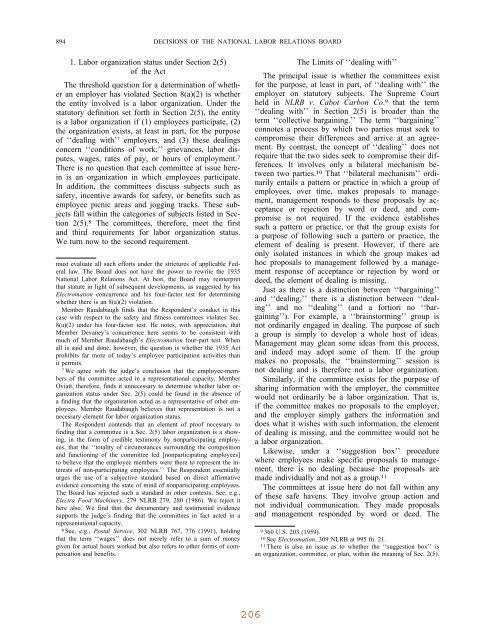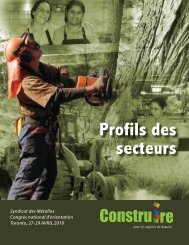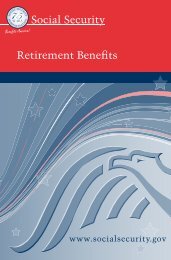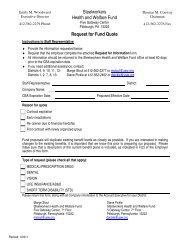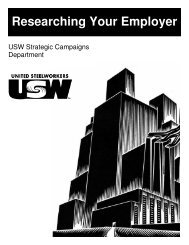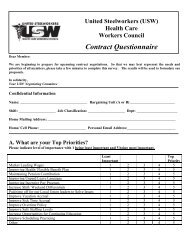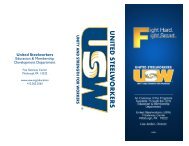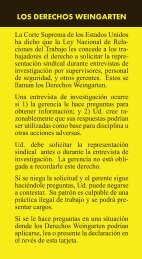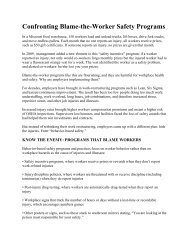Union Approach to Health and Safety: - United Steelworkers
Union Approach to Health and Safety: - United Steelworkers
Union Approach to Health and Safety: - United Steelworkers
You also want an ePaper? Increase the reach of your titles
YUMPU automatically turns print PDFs into web optimized ePapers that Google loves.
894 DECISIONS OF THE NATIONAL LABOR RELATIONS BOARD<br />
1. Labor organization status under Section 2(5)<br />
of the Act<br />
The threshold question for a determination of whether<br />
an employer has violated Section 8(a)(2) is whether<br />
the entity involved is a labor organization. Under the<br />
statu<strong>to</strong>ry definition set forth in Section 2(5), the entity<br />
is a labor organization if (1) employees participate, (2)<br />
the organization exists, at least in part, for the purpose<br />
of ‘‘dealing with’’ employers, <strong>and</strong> (3) these dealings<br />
concern ‘‘conditions of work,’’ grievances, labor disputes,<br />
wages, rates of pay, or hours of employment. 7<br />
There is no question that each committee at issue herein<br />
is an organization in which employees participate.<br />
In addition, the committees discuss subjects such as<br />
safety, incentive awards for safety, or benefits such as<br />
employee picnic areas <strong>and</strong> jogging tracks. These subjects<br />
fall within the categories of subjects listed in Section<br />
2(5). 8 The committees, therefore, meet the first<br />
<strong>and</strong> third requirements for labor organization status.<br />
We turn now <strong>to</strong> the second requirement.<br />
must evaluate all such efforts under the strictures of applicable Federal<br />
law. The Board does not have the power <strong>to</strong> rewrite the 1935<br />
National Labor Relations Act. At best, the Board may reinterpret<br />
that statute in light of subsequent developments, as suggested by his<br />
Electromation concurrence <strong>and</strong> his four-fac<strong>to</strong>r test for determining<br />
whether there is an 8(a)(2) violation.<br />
Member Raudabaugh finds that the Respondent’s conduct in this<br />
case with respect <strong>to</strong> the safety <strong>and</strong> fitness committees violates Sec.<br />
8(a)(2) under his four-fac<strong>to</strong>r test. He notes, with appreciation, that<br />
Member Devaney’s concurrence here seems <strong>to</strong> be consistent with<br />
much of Member Raudabaugh’s Electromation four-part test. When<br />
all is said <strong>and</strong> done, however, the question is whether the 1935 Act<br />
prohibits far more of <strong>to</strong>day’s employee participation activities than<br />
it permits.<br />
7 We agree with the judge’s conclusion that the employee-members<br />
of the committee acted in a representational capacity. Member<br />
Oviatt, therefore, finds it unnecessary <strong>to</strong> determine whether labor organization<br />
status under Sec. 2(5) could be found in the absence of<br />
a finding that the organization acted as a representative of other employees.<br />
Member Raudabaugh believes that representation is not a<br />
necessary element for labor organization status.<br />
The Respondent contends that an element of proof necessary <strong>to</strong><br />
finding that a committee is a Sec. 2(5) labor organization is a showing,<br />
in the form of credible testimony by nonparticipating employees,<br />
that the ‘‘<strong>to</strong>tality of circumstances surrounding the composition<br />
<strong>and</strong> functioning of the committee led [nonparticipating employees]<br />
<strong>to</strong> believe that the employee members were there <strong>to</strong> represent the interests<br />
of non-participating employees.’’ The Respondent essentially<br />
urges the use of a subjective st<strong>and</strong>ard based on direct affirmative<br />
evidence concerning the state of mind of nonparticipating employees.<br />
The Board has rejected such a st<strong>and</strong>ard in other contexts. See, e.g.,<br />
Electra Food Machinery, 279 NLRB 279, 280 (1986). We reject it<br />
here also. We find that the documentary <strong>and</strong> testimonial evidence<br />
supports the judge’s finding that the committees in fact acted in a<br />
representational capacity.<br />
8 See, e.g., Postal Service, 302 NLRB 767, 776 (1991), holding<br />
that the term ‘‘wages’’ does not merely refer <strong>to</strong> a sum of money<br />
given for actual hours worked but also refers <strong>to</strong> other forms of compensation<br />
<strong>and</strong> benefits.<br />
The Limits of ‘‘dealing with’’<br />
The principal issue is whether the committees exist<br />
for the purpose, at least in part, of ‘‘dealing with’’ the<br />
employer on statu<strong>to</strong>ry subjects. The Supreme Court<br />
held in NLRB v. Cabot Carbon Co. 9 that the term<br />
‘‘dealing with’’ in Section 2(5) is broader than the<br />
term ‘‘collective bargaining.’’ The term ‘‘bargaining’’<br />
connotes a process by which two parties must seek <strong>to</strong><br />
compromise their differences <strong>and</strong> arrive at an agreement.<br />
By contrast, the concept of ‘‘dealing’’ does not<br />
require that the two sides seek <strong>to</strong> compromise their differences.<br />
It involves only a bilateral mechanism between<br />
two parties. 10 That ‘‘bilateral mechanism’’ ordinarily<br />
entails a pattern or practice in which a group of<br />
employees, over time, makes proposals <strong>to</strong> management,<br />
management responds <strong>to</strong> these proposals by acceptance<br />
or rejection by word or deed, <strong>and</strong> compromise<br />
is not required. If the evidence establishes<br />
such a pattern or practice, or that the group exists for<br />
a purpose of following such a pattern or practice, the<br />
element of dealing is present. However, if there are<br />
only isolated instances in which the group makes ad<br />
hoc proposals <strong>to</strong> management followed by a management<br />
response of acceptance or rejection by word or<br />
deed, the element of dealing is missing.<br />
Just as there is a distinction between ‘‘bargaining’’<br />
<strong>and</strong> ‘‘dealing,’’ there is a distinction between ‘‘dealing’’<br />
<strong>and</strong> no ‘‘dealing’’ (<strong>and</strong> a fortiori no ‘‘bargaining’’).<br />
For example, a ‘‘brains<strong>to</strong>rming’’ group is<br />
not ordinarily engaged in dealing. The purpose of such<br />
a group is simply <strong>to</strong> develop a whole host of ideas.<br />
Management may glean some ideas from this process,<br />
<strong>and</strong> indeed may adopt some of them. If the group<br />
makes no proposals, the ‘‘brains<strong>to</strong>rming’’ session is<br />
not dealing <strong>and</strong> is therefore not a labor organization.<br />
Similarly, if the committee exists for the purpose of<br />
sharing information with the employer, the committee<br />
would not ordinarily be a labor organization. That is,<br />
if the committee makes no proposals <strong>to</strong> the employer,<br />
<strong>and</strong> the employer simply gathers the information <strong>and</strong><br />
does what it wishes with such information, the element<br />
of dealing is missing, <strong>and</strong> the committee would not be<br />
a labor organization.<br />
Likewise, under a ‘‘suggestion box’’ procedure<br />
where employees make specific proposals <strong>to</strong> management,<br />
there is no dealing because the proposals are<br />
made individually <strong>and</strong> not as a group. 11<br />
The committees at issue here do not fall within any<br />
of these safe havens. They involve group action <strong>and</strong><br />
not individual communication. They made proposals<br />
<strong>and</strong> management responded by word or deed. The<br />
9 360 U.S. 203 (1959).<br />
10 See Electromation, 309 NLRB at 995 fn. 21.<br />
11 There is also an issue as <strong>to</strong> whether the ‘‘suggestion box’’ is<br />
an organization, committee, or plan, within the meaning of Sec. 2(5).


